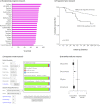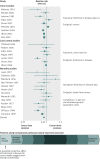Prognosis research strategy (PROGRESS) 1: a framework for researching clinical outcomes
- PMID: 23386360
- PMCID: PMC3565687
- DOI: 10.1136/bmj.e5595
Prognosis research strategy (PROGRESS) 1: a framework for researching clinical outcomes
Abstract
Understanding and improving the prognosis of a disease or health condition is a priority in clinical research and practice. In this article, the authors introduce a framework of four interrelated themes in prognosis research, describe the importance of the first of these themes (understanding future outcomes in relation to current diagnostic and treatment practices), and introduce recommendations for the field of prognosis research
Conflict of interest statement
Competing interests: All authors have completed the ICMJE uniform disclosure form at
Figures





Similar articles
-
Unexpected predictor-outcome associations in clinical prediction research: causes and solutions.CMAJ. 2013 Jul 9;185(10):E499-505. doi: 10.1503/cmaj.120812. Epub 2013 Jan 21. CMAJ. 2013. PMID: 23339155 Free PMC article. No abstract available.
-
Challenges and opportunities in economic evaluations of diagnostic tests and procedures.Acad Radiol. 1999 Jan;6 Suppl 1:S128-31. doi: 10.1016/s1076-6332(99)80107-x. Acad Radiol. 1999. PMID: 9891180 No abstract available.
-
Prognosis research strategy (PROGRESS) 4: stratified medicine research.BMJ. 2013 Feb 5;346:e5793. doi: 10.1136/bmj.e5793. BMJ. 2013. PMID: 23386361 Free PMC article.
-
When is the right time to conduct a clinical trial of a diagnostic imaging technology?Radiology. 2008 Jul;248(1):12-5. doi: 10.1148/radiol.2481072190. Radiology. 2008. PMID: 18566166 Review. No abstract available.
-
Prognosis Research Strategy (PROGRESS) 2: prognostic factor research.PLoS Med. 2013;10(2):e1001380. doi: 10.1371/journal.pmed.1001380. Epub 2013 Feb 5. PLoS Med. 2013. PMID: 23393429 Free PMC article. Review.
Cited by
-
Long-Term Survival, Morbidity, Social Functioning and Risk of Disability in Patients with a Herpes Simplex Virus Type 1 or Type 2 Central Nervous System Infection, Denmark, 2000-2016.Clin Epidemiol. 2020 Jul 16;12:745-755. doi: 10.2147/CLEP.S256838. eCollection 2020. Clin Epidemiol. 2020. PMID: 32765109 Free PMC article.
-
External validation and calibration of IVFpredict: a national prospective cohort study of 130,960 in vitro fertilisation cycles.PLoS One. 2015 Apr 8;10(4):e0121357. doi: 10.1371/journal.pone.0121357. eCollection 2015. PLoS One. 2015. PMID: 25853703 Free PMC article.
-
Clinical predictors of antipsychotic treatment resistance: Development and internal validation of a prognostic prediction model by the STRATA-G consortium.Schizophr Res. 2022 Dec;250:1-9. doi: 10.1016/j.schres.2022.09.009. Epub 2022 Oct 12. Schizophr Res. 2022. PMID: 36242784 Free PMC article.
-
Study protocol for the development and internal validation of Schizophrenia Prediction of Resistance to Treatment (SPIRIT): a clinical tool for predicting risk of treatment resistance to antipsychotics in first-episode schizophrenia.BMJ Open. 2022 Apr 8;12(4):e056420. doi: 10.1136/bmjopen-2021-056420. BMJ Open. 2022. PMID: 35396294 Free PMC article.
-
Prognostic Factors for Delayed Healing of Complex Wounds in Adults: A Scoping Review Protocol.Nurs Rep. 2022 Nov 23;12(4):904-911. doi: 10.3390/nursrep12040087. Nurs Rep. 2022. PMID: 36548160 Free PMC article.
References
-
- Department of Health. White paper. Equity and excellence: liberating the NHS. Stationery Office, 2010.
-
- Riley RD, Hayden JA, Steyerberg EW, Moons KGM, Abrams K, Kyzas PA, et al. Prognosis research strategy (PROGRESS) 2: Prognostic factor research. PLoS Med 2013, 10.1371.journal/pmed.1001380. - DOI - PMC - PubMed
-
- Steyerberg EW, Moons KGM, van der Windt DA, Hayden JA, Perel P, Schroter S, et al. Prognosis research strategy (PROGRESS) 3: Prognostic model research. PLoS Med 2013, 10.1371.journal/pmed.1001381. - DOI - PMC - PubMed
Publication types
MeSH terms
Grants and funding
LinkOut - more resources
Full Text Sources
Other Literature Sources
